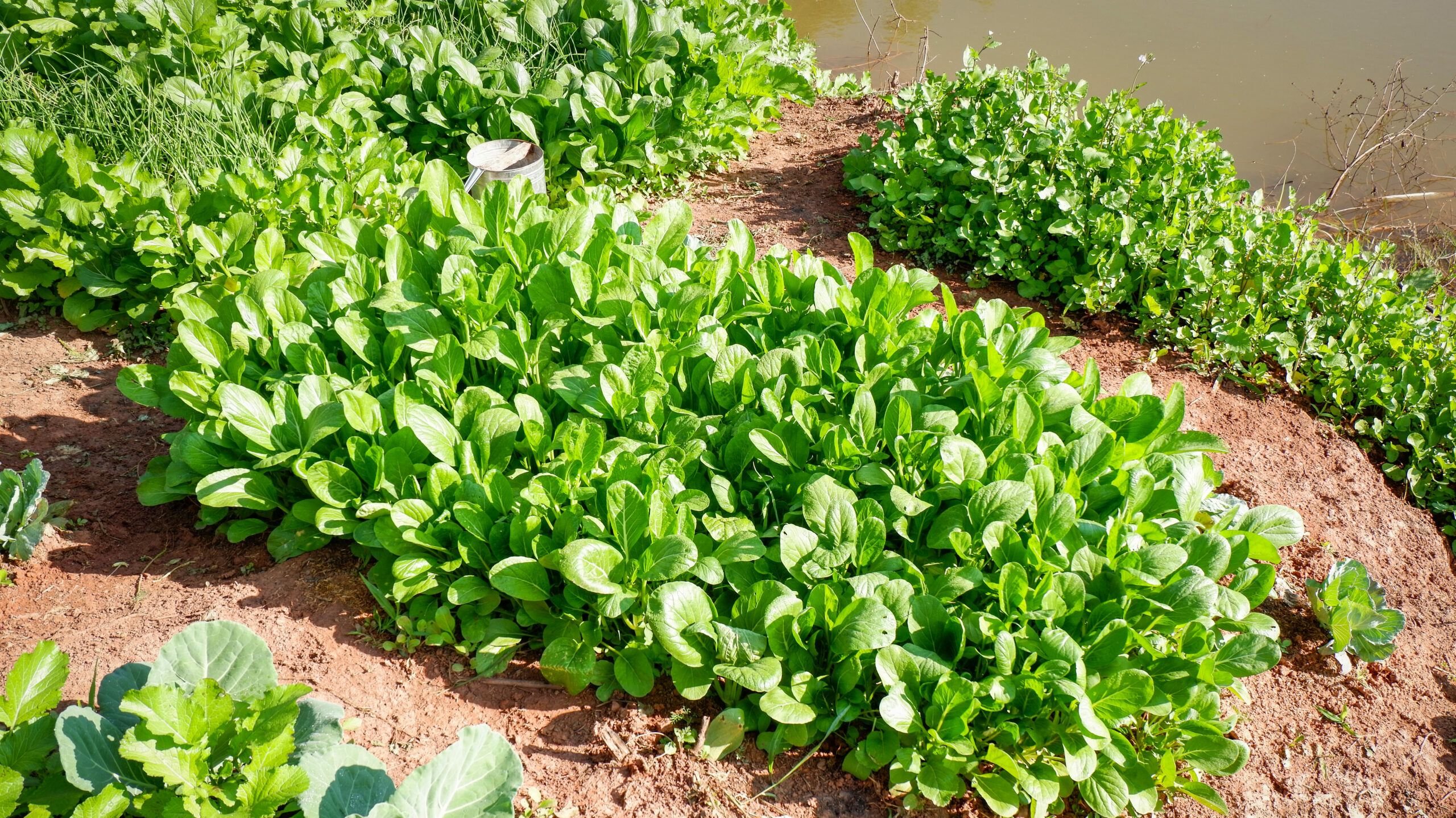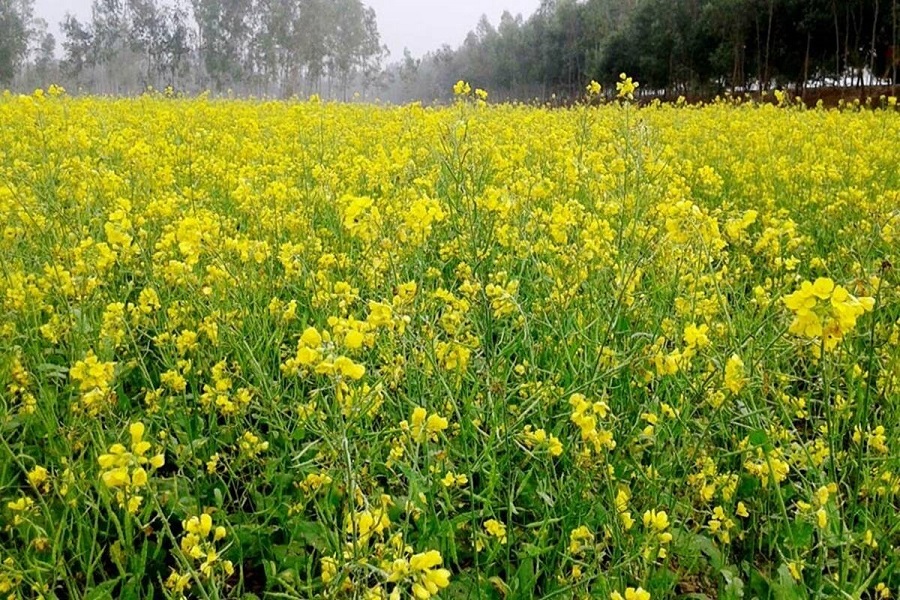
Everyone knows the condiment made from mustard seeds, but not everyone has heard of growing mustard greens! The leaves are large and nutritious like those of beets and turnips.
Mustard has been an important spice for thousands of years, having been used in ancient cultures such as India, China, and Rome as a condiment and an ingredient in stir-fries.
Multiple mustard varieties exist for different purposes. You can get spinach varieties whose leaves taste like their namesake, spicy varieties that will come hot off the plant, and cut-and-come-again varieties for greens.
About mustard varieties
Although there are roughly 40 different species of mustard in the wild, only 3 are cultivated:
- Yellow (sinapis alba): The famous American hot dog mustard is made from this one, and it originates in the Mediterranean. It’s the mildest of the three.
- Brown (brassica juncea): Brown mustard is the one found in Chinese restaurants. It’s spicier than yellow mustard and is often combined with turmeric.
- Black (brassica nigra): Black mustard originates in the Himalayan mountains. It’s the most pungent of the three and it’s often used in curry sauces in India.
Preparing the Growing Environment
- Soil: Mustard plants like well-drained soil with a pH of close to 7 (neutral). If your soil isn’t ideal for mustard, consider using raised beds (just like strawberries).
- Sunlight: Mustard is a cool-weather crop that prefers full sun. In hotter regions, you may want to plant it in light shade to prevent it from bolting or grow it during the cool season.
- Nutrition: Mustard can tolerate poorer-quality soil but you can boost it by adding an organic mulch.
Planting Techniques
- Starting: Seeds can be sown directly into the ground around 3 weeks before your local frost date. In colder regions, you may start them indoors in early spring to lengthen the growing season. Harden them off for a few days before planting them outside.
- Spacing: The spacing of the plants depends on the variety, but typically they are best placed 2 to 3 feet apart. If you’re only growing them for the greens, you can plant them as close as 1 foot apart.
- Support: If you’re growing mustard for seed, staking plants for support is a good idea, especially in windy regions.
- Frost: You can plant your seeds about 3 weeks before your local frost date. Mustard can tolerate a light frost, but prolonged freezing will harm the plants.
Care and Maintenance
- Watering: Keep the soil moist but not waterlogged. You can test the soil moisture with your index finger. If it’s a dry year, water more often to ensure the leaves won’t become bitter.
- Fertilizer: For mustard, a fertilizer high in nitrogen is ideal during the early stages for leaf growth. After the plant is well-established, switch to a balanced fertilizer.
- Weeds: Despite being a prolific and easy-to-grow plant, mustard does not compete well with weeds. Be sure to keep your garden beds weeded and use companion planting to help drown them out.
- Pests: Mustard is a member of the brassica family which also has cabbage and broccoli, so the same pests that attack these also go for mustard. (Flea Beetles, Cabbage Loopers, Slugs and Snails)
- Diseases: Most fungal infections can be prevented by being careful not to water the leaves of your plants. Spacing them apart allows for airflow which keeps them dry.
Growth and Development Stages
Mustard grows in stages:
- Mustard germinates quickly and can appear in as little as 5 days after sowing. It’s common to thin your plants as they grow to allow for adequate spacing, and you can eat the greens of the mustard seedlings you pull up.
- The plant will grow rapidly during the first few weeks, producing greens for photosynthesis. These early leaves are delicious and are often harvested as microgreens.
- After 8 to 12 weeks, the plant will begin to produce flowers, which bees love. These flowers turn into seed pods, which turn brown as they dry out and drop the seeds.
Mustard plants face certain growth challenges:
- Seeds Not Germinating: Check the pH of the soil. For example, the acidic soils that plants like tomatoes love don’t favor brassicas like mustard.
- Plants Bolting: Like many plants, mustard will bolt (go to seed prematurely) if its growing conditions are bad or change suddenly. For example, mustard plants may bolt if exposed to too much sun, or if transplanted outside without being hardened off first.
Harvesting Mustard

- When your seed pods are brown and dry, it’s time to harvest. Don’t leave it too long or the seeds will drop out and your harvest will be lost!
- Leaves can be harvested as soon as they appear, and are delicious up until the plant starts going to seed.
- Cut the stems off the plant and hang them over a paper bag to catch the seeds. Once the pods are completely dry, shake loose all the seeds and run them through a sieve to remove the pods. You can also use a fan to blow the chaff away while you pour the seeds back and forth between two bowls.
Preservation and Storage
- Mustard leaves do not store well and should be used within 2 to 3 days of harvesting.
- You can prepare your seeds for storage by running them through a dehydrator with only airflow and no heat, or by slow-drying them at a cool temperature.
- Don’t grind up the seeds until you’re ready to use them.
Common Pests and Diseases
Many pests and diseases can be avoided by leaving space between plants for airflow, watering the ground and not the leaves, weeding the garden bed, and not planting brassicas together.
- Flea Beetles: Little bugs that gnaw holes in the leaves. Best removed with insecticidal soap.
- Cabbage Loopers: These are caterpillars that attack brassica members. Ladybugs eat their eggs.
- Slugs and Snails: prevent these little monsters by eliminating their habitats, like long grass and piles of organic material near the garden.
- Anthracnose: A fungus that causes holes in the leaves to appear. It’s often transferred by infected seed.
- Damping Off: Affects baby plants. It causes them to wilt and acts quickly. It’s caused by bad soil drainage.
It is time to grow your own Mustard
If you’ve ever thought about growing your own mustard, there’s no time like the present! It’s easy to grow and practically grows itself, as long as you fend off the weeds and give the plants enough space. If you want to know more about how to grow mustard seeds, consider talking to an expert at a plant nursery. Best of luck and happy gardening!
Frequently Asked Questions
Mustard grows quickly, germinating in as little as 5 days. The plants grow larger than most other vegetable plants.
How Big Does a Mustard Seed Grow?
Mustard plants can grow up to 3 feet tall and wide, depending on the variety.
Does a Mustard Seed Grow Into a Tree?
No, mustard plants are not technically trees, though some species of mustard grow rather large.
Can You Grow Mustard Seeds Indoors?
Yes, as long as you have a large enough pot (depending on the variety) and adequate sunlight.
Where Does Mustard Grow?
Different varieties of mustard are grown from India and other regions of Asia to the Mediterranean and all over North America. It’s cultivated both for food and as a cover crop and is best grown in fertile, well-drained soil.
Do Mustard Greens Grow Back?
Yes, mustard plants regrow their leaves after being harvested.

